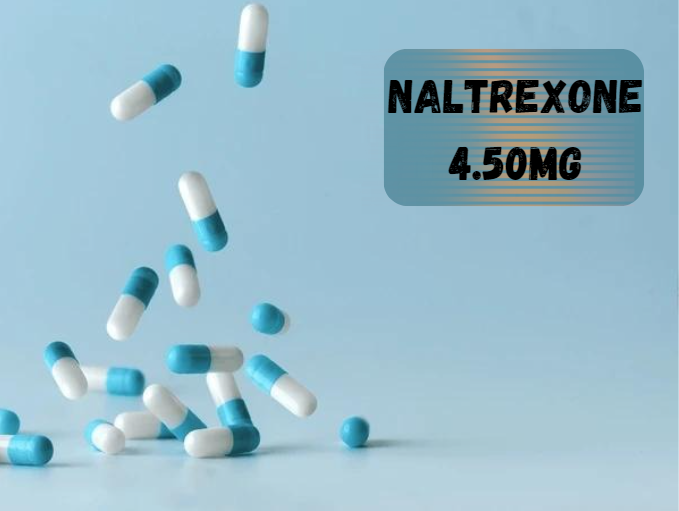Naltrexone 4.50mg: A Comprehensive Guide to its Uses, Benefits, and Insights
Naltrexone 4.50mg has emerged as a noteworthy preparation in modern medicine, particularly for its off-label uses. Initially approved for managing opioid and alcohol dependence, its lower-dose formulation, specifically 4.5mg, has garnered attention for treating a variety of conditions including fibromyalgia, psoriasis, and complex regional pain syndrome type I.
This article aims to provide an in-depth exploration of Naltrexone 4.50mg, offering unique interpretations, analyses, and insights that extend beyond existing literature.
Contents [hide]
Understanding Naltrexone 4.50mg
What is Naltrexone?
Naltrexone is an opioid antagonist, which means it blocks the effects of opioids in the brain. It was first approved by the FDA in 1984 for the treatment of opioid dependence and later for alcohol dependence.
Naltrexone works by binding to opioid receptors without activating them, thus preventing other substances like heroin or alcohol from eliciting their pleasurable effects. This mechanism makes it an effective tool in addiction treatment.
The Significance of the 4.50mg Dosage
The standard dosages of Naltrexone for addiction treatment are 50mg to 100mg. However, the 4.50mg dosage, often referred to as Low Dose Naltrexone (LDN), is significantly lower and has been investigated for its potential benefits in treating various chronic pain conditions and autoimmune diseases.
The concept of LDN was popularized by Dr. Bernard Bihari in the 1980s, who discovered its utility in lower doses for conditions beyond addiction.
Naltrexone 4.50mg in Treating Fibromyalgia
Mechanism of Action
Fibromyalgia is a chronic condition characterized by widespread musculoskeletal pain, fatigue, and tenderness in localized areas. The exact cause of fibromyalgia is unknown, but it is believed to involve a combination of genetic, environmental, and psychological factors. Naltrexone 4.50mg is thought to alleviate symptoms of fibromyalgia through its anti-inflammatory and immunomodulatory effects.
By blocking Toll-like receptor 4 (TLR4) on microglia, Naltrexone reduces the release of pro-inflammatory cytokines, which are believed to play a role in the pain and fatigue experienced by fibromyalgia patients.
Clinical Evidence
Several studies have highlighted the efficacy of Naltrexone 4.50mg in reducing fibromyalgia symptoms. A pilot study conducted by Dr. Jarred Younger and colleagues at Stanford University showed a significant reduction in pain and overall symptoms in patients taking LDN compared to a placebo. Subsequent research has supported these findings, suggesting that LDN can be a promising adjunctive treatment for fibromyalgia.
Patient Insights
Patients using Naltrexone 4.50mg for fibromyalgia have reported improvements in pain, sleep quality, and overall well-being. Many patients appreciate the minimal side effects compared to other medications traditionally prescribed for fibromyalgia, such as antidepressants and anticonvulsants.
Naltrexone 4.50mg and Psoriasis
Understanding Psoriasis
Psoriasis is an autoimmune disease characterized by rapid skin cell proliferation leading to thick, red, scaly patches. The inflammation associated with psoriasis is driven by an overactive immune response, making immunomodulatory treatments like Naltrexone 4.50mg particularly appealing.
Mechanism of Action
The anti-inflammatory properties of Naltrexone 4.50mg are believed to play a crucial role in its effectiveness against psoriasis. By modulating the immune response and reducing the activity of inflammatory cells, Naltrexone helps to decrease the severity of psoriasis lesions.
Clinical Evidence
Research on the use of Naltrexone 4.50mg for psoriasis is still in its early stages, but preliminary studies and anecdotal evidence are promising. Patients have reported significant improvements in skin appearance and a reduction in the frequency and severity of flare-ups.
Patient Insights
Patients using Naltrexone 4.50mg for psoriasis often highlight the convenience of a single daily pill with minimal side effects compared to other systemic treatments like biologics, which can have more severe adverse effects.
Naltrexone 4.50mg for Complex Regional Pain Syndrome Type I
Understanding CRPS Type I
Complex Regional Pain Syndrome (CRPS) Type I is a chronic pain condition typically affecting a limb after an injury. It is characterized by prolonged pain, changes in skin color and temperature, and swelling. The exact cause of CRPS is unknown, but it is thought to involve a malfunctioning peripheral and central nervous system.
Mechanism of Action
The anti-inflammatory and pain-modulating properties of Naltrexone 4.50mg are beneficial in managing CRPS Type I. By reducing the activity of microglia and pro-inflammatory cytokines, Naltrexone helps to alleviate pain and improve function.
Clinical Evidence
While large-scale clinical trials are lacking, smaller studies and case reports suggest that Naltrexone 4.50mg can be effective in reducing pain and improving quality of life for patients with CRPS Type I. More research is needed to establish its efficacy and optimal usage.
Patient Insights
Patients with CRPS Type I who have tried Naltrexone 4.50mg report varied results, but many have experienced significant pain relief and improved mobility. The low side effect profile of Naltrexone 4.50mg makes it a preferred option for long-term management of chronic pain.
Other Potential Uses of Naltrexone 4.50mg
Autoimmune Diseases
Beyond fibromyalgia and psoriasis, Naltrexone 4.50mg is being explored for its potential in treating other autoimmune diseases such as multiple sclerosis (MS), rheumatoid arthritis (RA), and Crohn’s disease. The immunomodulatory effects of Naltrexone make it a promising candidate for these conditions, although more research is needed to confirm its efficacy.
Mental Health Conditions
There is growing interest in the potential of Naltrexone 4.50mg to treat mental health conditions like depression and anxiety. The exact mechanism is not well understood, but it is hypothesized that Naltrexone’s effects on inflammation and neurotransmitter systems could play a role.
Cancer
Some early studies suggest that Naltrexone 4.50mg might have anti-tumor effects, potentially making it a valuable adjunct in cancer treatment. Research in this area is still in its infancy, and more studies are required to determine its effectiveness and safety.
FAQs About Naltrexone 4.50mg
What is Naltrexone 4.50mg used for?
Naltrexone 4.50mg is used off-label for conditions such as fibromyalgia, psoriasis, complex regional pain syndrome type I, and other chronic pain and autoimmune diseases. It is also being explored for mental health conditions and cancer treatment.
How does Naltrexone 4.50mg work?
Naltrexone 4.50mg works by modulating the immune system and reducing inflammation. It blocks Toll-like receptor 4 (TLR4) on microglia, leading to a decrease in pro-inflammatory cytokines and alleviating pain and other symptoms.
Are there any side effects of Naltrexone 4.50mg?
Naltrexone 4.50mg is generally well-tolerated with minimal side effects. Some patients may experience mild gastrointestinal symptoms, headaches, or dizziness, especially when starting the medication.
Is Naltrexone 4.50mg safe for long-term use?
Studies and patient reports suggest that Naltrexone 4.50mg is safe for long-term use, with a low incidence of serious side effects. However, patients should be monitored regularly by their healthcare provider.
Can I use Naltrexone 4.50mg with other medications?
Naltrexone 4.50mg can be used with other medications, but it is important to discuss all medications and supplements with your healthcare provider to avoid potential interactions.
Conclusion
Naltrexone 4.50mg is a versatile medication with potential benefits extending far beyond its original use in addiction treatment. Its application in treating chronic pain conditions, autoimmune diseases, and possibly even mental health disorders and cancer, highlights its multifaceted therapeutic potential.
While more research is needed to fully understand and optimize its use, the existing evidence and patient experiences suggest that Naltrexone 4.50mg could play a significant role in modern medicine.
As with any medication, it is crucial for patients to consult with their healthcare provider to determine if Naltrexone 4.50mg is appropriate for their specific condition and to ensure safe and effective use.






















































Post Comment